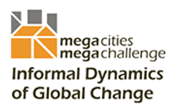Border Drawing and Spatial Differentiation of Urban Governance Modes in the Pearl River Delta with Special Regard to Informal Development and Self-Organisation
(project completed)
Background
The Pearl River Delta Region in China is an extraordinary example for mega city growth. Not only does the region include several cities - which on their own fulfil the population criteria for mega cities - but also the whole region is growing together to eventually become a single mega city region. This development is driven by global economic and political change as well as the specific transformation process of the People’s Republic of China. The proposed project, as an integral part of the wider DFG Priority Programme “Mega cities – mega challenge: Informal dynamics of global change”, will focus on the governability issue in relationship with the dynamics of land-use and land-cover change in the process or urbanisation. The governing of mega cities is generally a challenge, but it is an even more complex issue in developing and transformation countries.
Introduction
Our project is implemented as a co-operation of the University of Kassel, the University of Hamburg (both Germany), and the Sun Yat-sen University of Guangzhou (China). Study region: We focus on the spatially differentiated use of governance modes in the Pearl River Delta mega-urban region, in particular Guangzhou, Dongguan, Shenzhen, Zhuhai, Zhongshan as well as Foshan. Our research will also consider Hong Kong and Macau.
Overall Objectives
The project aims to identify different governance modes, to understand the role of self-organization and informal processes for these modes and to link the practice of differentiated governance with the creation of bounded space.
Results
The findings shall contribute to the understanding of governance in transitional China as well as to the general issue of governability of mega-urban regions, in particular with:
- the identification and explanation of area specific governance modes;
- an analysis of the structural power of borders; and
- the explanation of changing formal-informal relationships, the gradual use of self-organization, and the economic, political as well as urban development background in the context of transitional China.
Our Approach
We assume that border-drawing and differentiated governance are used to ensure the governability of this highly dynamic and very diverse mega-urban region. By analyzing various types of bounded places of work and residence, we aim at building a typology of governance modes. Conceptually, we focus on three categories of spatial entities: administrative, economic and residential units. For these entities, we identify mechanisms of inclusion and exclusion, we analyze the significance of boundaries for their governance, and we explore the social implications.
Important Hypotheses
- Distinct governance modes co-exist simultaneously in separated spatial units within the Pearl River Delta Region.
- Differentiated urban governance and the creation of borders facilitate the governability of mega-urban regions.
- The drawing of borders establishes patterns of inclusion and exclusion, which have significant social impacts.
- Informal processes and self-organization interact in different ways with the different governance modes.
Further Information
If you would like to have more information, please feel free to download our project brochure (pdf, 317 kB), visit our project website at www.bordersandgovernance.gwdg.de, or contact us (see contact details below).
Research Team
Study Group “Residential Entities” (University of Kassel, Department of Urban Regeneration):
- Prof. Dr.-Ing. Uwe Altrock, Phone: +49-561-804.3225; Email: altrock(at)asl.uni-kassel.de
- Dr. Sonia Schoon, Phone: +49-561-804.2783; Email: schoon(at)asl.uni-kassel.de
Study Group “Borders” (Sun Yat-sen University (Guangzhou), School of Geography and Planning)
- Assoc. Prof. Dr. Werner Breitung, Phone: +86-20-84.114.105; Email: breitung(at)gmail.com
- Michael Arri M.A., Phone: +86-135.2103.0011; Email: m.arri(at)gmx.de
Study Group “Economic Entities”(University of Hamburg, Institute of Geography)
- Assist. Prof. Dr. Michael Waibel, Phone: +49-40-42838.4909; Email: mwaibel(at)gwdg.de
- Dipl.-Geogr. Matthias Becker, Phone: +49-40-42838.5217; Email: rmbecker(at)gmx.de
Publications
Altrock, U., Waibel, M. (2008): Between Competitiveness and Efficiency – Metropolitan Governance as a tool to improve cooperation in mega-urban regions? Experiences from the German debate. In: Planning and Development (Annual Journal of the Hong Kong Institute of Planners) 23, No. 1, pp. 29-43. [online access]
-
Becker, M., Waibel, M., Altrock, U. (2007): Wirtschaftliche Sonderzonen als Ausgangspunkt zur Erklärung der Entwicklung der megaurbanen Region Perlflussdelta in China - Diskussion einer empirischen Operationalisierung anhand von "modes of governance". In: Pacific News July/August 2007, No. 1, pp. 26-31. [online access]
Breitung, W., Becker, M., Schoon, S. (2007): Analysis of Governance Modes in the Chinese Context - On the Adaptation of a Western Concept. Conference paper, Conference on “Public Governance – Theories and Practices”, Universidad de Macao, Macau. [online access]


